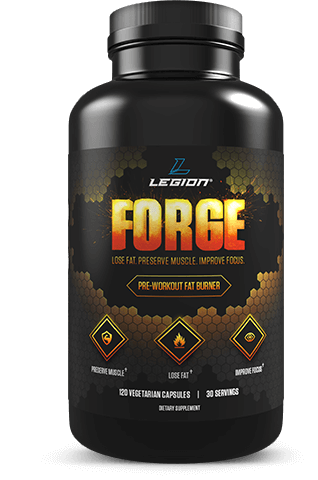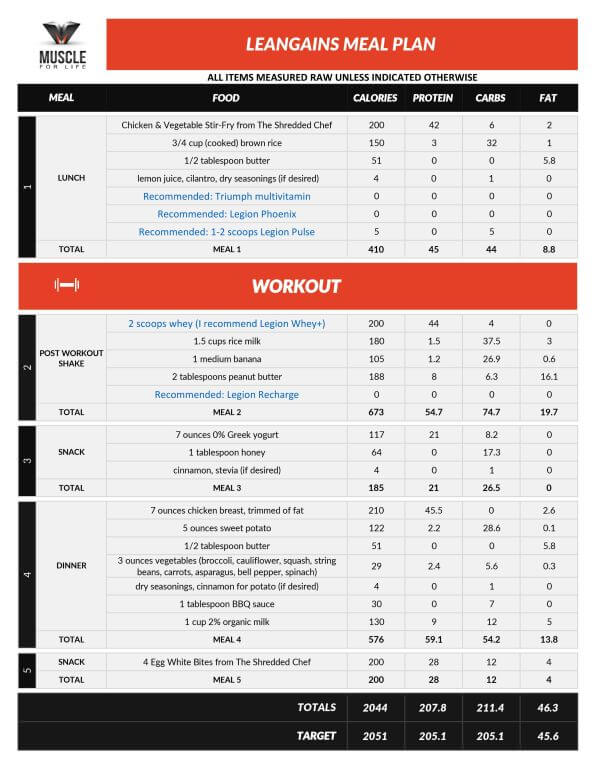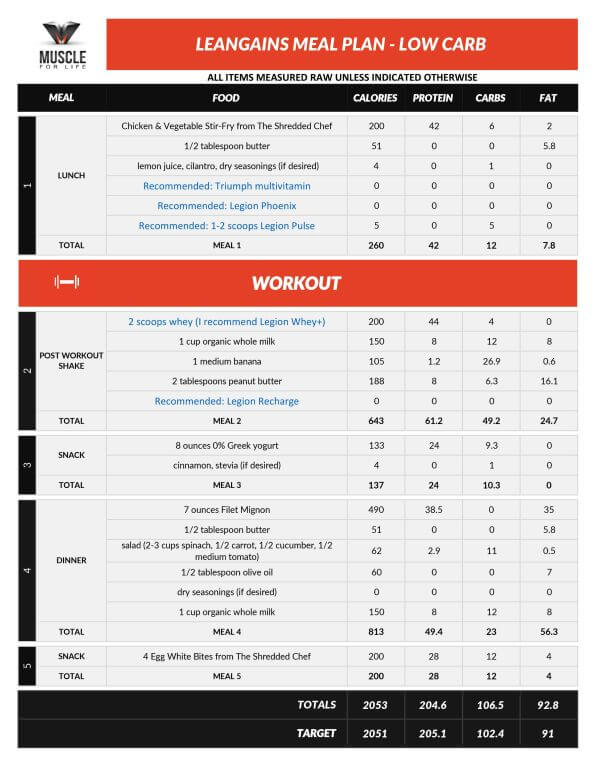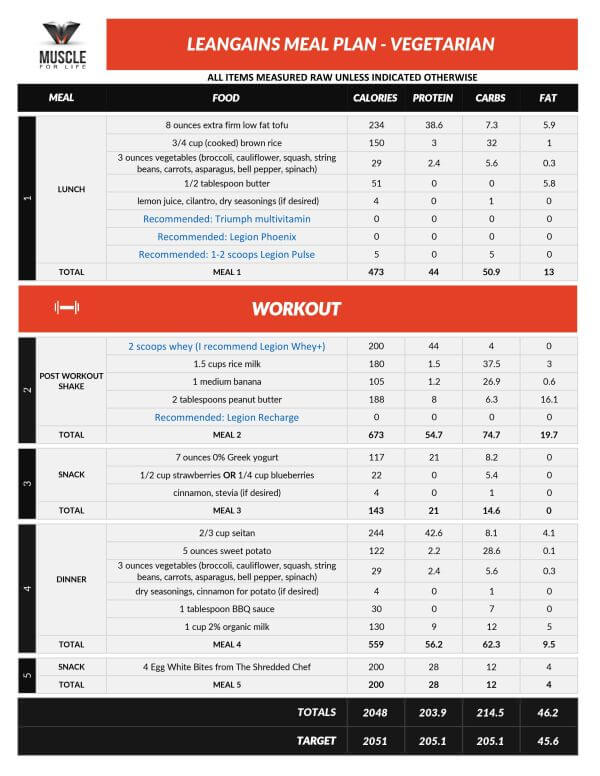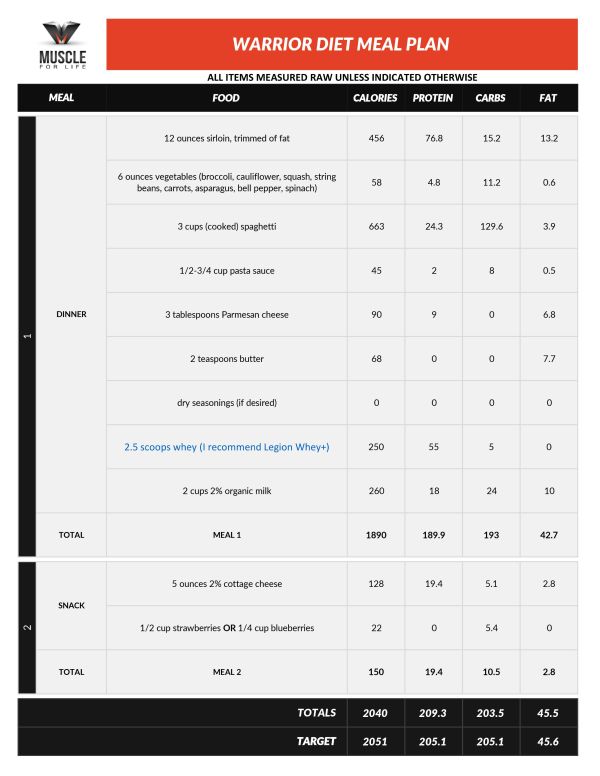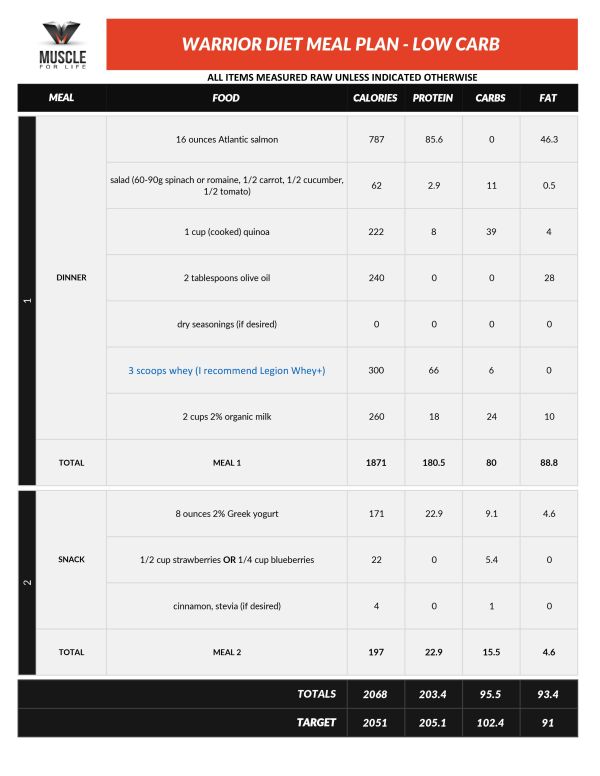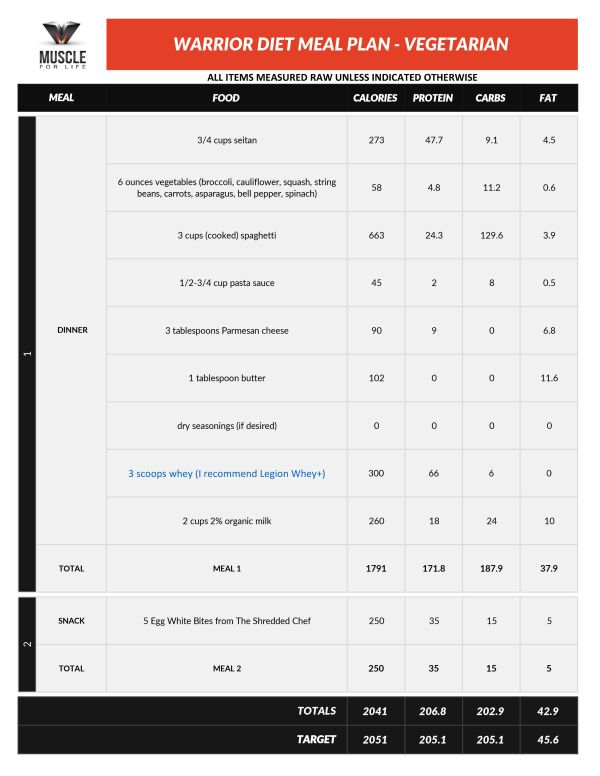“That sounds dumb. And bad. And really uncomfortable.”
That’s what I said years ago when I first heard about intermittent fasting.
And I’ve eaten every last one of those words since.
Intermittent fasting isn’t dumb or bad and it doesn’t have to be uncomfortable.
Now, in my defense, the principles of intermittent fasting and the promises made by its biggest advocates warrant skepticism.
Consuming zero calories for 16, 18, 24, or even 36 hours and then “feasting” is somehow beneficial?
It will help you lose weight faster…build more muscle…improve mental performance…age slower…and ward off disease?

Come on.
That’s a diet that sounds like it belongs in the bargain bin with the rest of the faddish nonsense that health “gurus” churn out every January.
And I was surprised to learn that it doesn’t.
In fact, scientific research on intermittent fasting has helped tip some of the biggest, doddering sacred cows of diet and nutrition.
That said, it’s also not the quantum leap in dieting that Clickbank hucksters would have you believe.
As you’ll soon see, intermittent fasting…
- may help you lose fat faster and maintain your body composition,
- it probably won’t help you build more muscle,
- and it may be beneficial to your health.
The long story short is this:
If you feel IF is for you, great. You can do well with it. If you don’t, however, you don’t have to worry that you’re missing out on anything groundbreaking.
A traditional diet is still highly effective for losing fat, building muscle, and staying healthy…and it always will be.
But I’m getting ahead of myself.
Let’s start this journey with a definition of terms…
Table of Contents
+What Is Intermittent Fasting?

“Intermittent fasting” is a semi-perfect description of what it is.
You fast…but not necessarily intermittently. In fact, some methods have to do the opposite–fast on a regular schedule.
Before we go into the mechanics of this method of dieting, though, let’s take a closer look at what “fasting” is. Many people assume it’s simply not eating food or having an empty stomach, but it’s a bit more than that.
What Is “Fasting”?
When you eat food, it gets broken down into various molecules that your cells can use like amino acids, glucose, and fatty acids.
These molecules find their way into your blood along with insulin, whose job is to shuttle them into cells.
Insulin levels rise in proportion to the size and composition of the meal. The larger the meal and higher in protein and carbohydrate it is, the larger the insulin response.
The size and composition of the meal also determines how long insulin levels remain elevated for (anywhere from 2 to 6+ hours).
When your body is digesting and absorbing the food you’ve eaten and insulin levels are “up,” you’re in a “fed” or “postprandial” state.
(Prandial means having to do with a meal.)
Once your body has finished processing the food and nutrients, however, insulin levels drop to a low, baseline level and you’re now in a “fasted” or “postabsorptive” state.
(You’ve probably heard of “fasted training,” which we’ll talk more about soon, and this is what it’s referring to–exercising while your insulin levels are at a baseline level.)
So, to recap:
- When insulin levels are elevated and food is still being processed and absorbed, you’re in a fed state.
- When insulin levels are at a low, baseline level and food is no longer being processed and absorbed, you’re in a fasted state (or could be said to be “fasting”).
How Does Intermittent Fasting Work?
As you can guess, intermittent fasting places special emphasis on…fasting. And while it’s particularly popular for weight loss but, this isn’t its only use.
At its core, intermittent fasting is simply a style of dieting that concerns itself most with when instead of what you eat, and the general goal is to spend more time every day and/or week in a postabsorptive (low insulin) than postprandial (high insulin) state.
You see, with a normal type of diet, you eat food every few hours from, let’s say, 8 AM until 9 PM.
That is, every day you eat food intermittently for ~13 hours and eat nothing for ~11 hours.
Due to the time it takes to process food, and depending on the size and composition of your final meal of the day, this means the majority of the time your body spends in a postabsorptive state will be when it’s asleep. (~6 to 7 hours is probably the average.)
With intermittent fasting, you flip this around.
You eat food intermittently for, let’s say, ~8 hours, and eat nothing for ~16 hours (the Leangains method, which we’ll discuss in detail later in this article).
So, for example, you might start eating at 1 PM and stop at 9 PM and not eat again until 1 PM the next day.
This way, your body spends significantly more time in a postabsorptive state. Again, the size and composition of your final meal affects this, but 12 to 14 hours is a reasonable average.
Now, why all the emphasis on fasting?
I’m glad you asked!
The Benefits of Fasting

One of the easiest ways to invent a fad diet is to isolate some aspect of eating and hang everything else on it.
- Low-carb crusaders hold up one macronutrient–the carbohydrate–as the gateway drug to obesity, disease, racism, Keeping Up With the Kardashians, and everything else wrong in the world.
- Paleo advocates claim that our dietary habits should follow a terribly flawed understanding of what our ancient ancestors ate.
- Gluten-free muppets bang on about how a protein harmless to the vast majority of the population is destroying our brainz and must be stamped out of existence.
And then there’s intermittent fasting, which puts fasting up on a pedestal.
Hence my initial cynicism.
Well, there’s no better way to alleviate cynicism than with science, and waddayaknow, research shows that fasting is good for the body.
Specifically, there are physiological processes that only occur when in a fasted state, mainly relating to the disposal of waste and the reparation of cells.
One of the more important processes that fasting induces is known as “autophagy,” which is crucial for maintaining muscle mass and counteracting some of the degenerative aspects of aging.
In fact, autophagy is the primary anti-aging mechanism of calorie restriction, which has made headlines for its longevity benefits.
Furthermore, research shows that fasting can reduce inflammation biomarkers, improve insulin sensitivity, elevate growth hormone levels, and reduce oxidative damage to various tissues and DNA.
In many ways, fasting is like a systemic “reset” button and research shows it confers a variety of health benefits.
Well, one of the primary purposes of intermittent fasting is to hit the button more frequently.
Now, you might be a little confused at this point.
I started this article lukewarm about intermittent fasting, basically saying you can take it or leave it and do fine either way.
And now I sound like an IF cheerleader about to pitch you on my latest “fat shredding” program.
What gives?
Who the hell knows. I’m just making this up as I go anyway.
Just kidding. 😉
Bear with me. We have a lot to cover but by the end, I think you’ll fully understand my position and know what’s best for you.
So, let’s carry on…
Is Intermittent Fasting Healthier Than Traditional Dieting?

There’s no question that cool stuff happens when you’re fasting.
The real question, however, is if intermittent fasting is clearly better for your health than traditional continuous-energy dieting.
And the jury’s still out on that one.
You see, intermittent fasting is still in its scientific infancy, with only a handful of controlled human studies under its belt.
For example, intermittent fasting proponents will often tout research conducted by the USDA as conclusive proof that they have a better mousetrap.
This study showed that men eating one meal per day lost more weight than those that ate three, and gained some muscle to boot.
If you go beyond the abstract and read the entire study, though, you’ll find some serious flaws:
- A small sample size (15 participants completed the trial).
- A short duration (2 week lead-in and 6-week treatment period).
- A 28% dropout rate (why did so many people quit?).
- The use of bioelectrical impedance analysis for body composition, which is notoriously inaccurate.
(One study using BIA showed that 42 days of fasting caused a 32% decrease in body fat and gains in lean mass… Yeah, okay.)
Unfortunately, this means the results of the USDA study are essentially worthless.
Another vital thing you need to realize is exercise alone provides many of the health benefits associated with intermittent fasting.
If you’re obese, hate moving, and want to lose weight and get healthier, then a low-carb (even ketogenic) intermittent fasting protocol is probably a good way to go.
If you’re a healthy adult that exercises regularly, however, will intermittent fasting provide any special health benefits?
We don’t know yet.
This must be kept in mind whenever you’re evaluating any type of diet, by the way. Exercise is the single most healthful habit you can have and can compensate for all kinds of dietary sins.
I always find it ironic when people that are neurotically fastidious about their diets and health but don’t exercise regularly.
The “cleanest” eater in the world that doesn’t exercise frequently is, in time, going to be much worse off than the “flexible dieter” that spends a few hours per week in the gym.
Intermittent Fasting and Weight Loss

Like any form of dieting, the majority of people turning to intermittent fasting want to lose weight.
And yes, it can work just fine for this purpose.
“Losing weight” isn’t a good goal, though. Losing fat is.
This distinction is important because you can starve yourself and do a ton of cardio and lose weight quickly…but a fair amount of it is going to be muscle.
And what happens you when you take this too far…losing large amounts of both fat and muscle?
You wind up skinny fat.
This is why preserving muscle is so important when you’re in a calorie deficit.
And this raises the question…
Doesn’t Fasting Cause Muscle Loss?

If you’ve always believed that, I understand.
That was one of my first questions when I heard about intermittent fasting, too.
You see, before the research undergirding IF went mainstream, “everyone knew” that you had to eat food (and protein) in particular at least every 5 to 6 hours or your body would start breaking down muscle tissue.
Well, we no know that’s not the case.
And to understand why, let’s review why and when the body breaks muscle tissue down.
Glucose, or blood sugar, is a great source of energy for your cells and organs. The easiest way to provide your body with glucose is to eat carbs, but your body is also able to create it out of other substances, such as amino acids (found in proteins) and glycerol (found in body fat).
The process whereby non-carbhoydrate substances are turned into glucose is known as “gluconeogenesis.”
Now, when you’re fasting, your body must rely on its own energy stores, and it has two primary sources of glucose:
- Glycogen stored in the liver.
Glycogen is a form of carbohydrate that can be quickly converted into glucose.
- Body fat.
When fat cells are mobilized, they release fatty acids into the blood, which many of your cells can burn for energy, as well as glycerol, which can be converted into glucose.
So long as the body can turn to these two energy sources to sustain itself, it has no reason to cannibalize muscle.
As the liver runs out of glycogen, however, the body turns to converting amino acids into glucose. And where does it get these amino acids? Muscle tissue.
This study found that amino acids obtained from the breakdown of muscle tissue were responsible for about 50% of glucose maintenance at the 16-hour mark of fasting, and 100% at the 28-hour mark.
This is why many intermittent fasting protocols designed for athletes and bodybuilders don’t have you fasting for more than 16 hours.
Furthermore, this is why well-designed protocols also recommend that your last meal before the fast be high in a slow-burning form of protein like casein or egg.
The purpose of this is to provide the body with a large infusion of amino acids so, as liver glycogen stores are depleted, it doesn’t have to break down muscle tissue to obtain the raw materials needed for gluconeogenesis. Instead, it can use the amino acids provided by the protein, which will remain available for several hours after eating.
The bottom line is fasting can cause muscle loss but won’t if it’s done properly.
What About “Starvation Mode”?

Whenever I hear diet “experts” blather about how infrequent eating puts the body into “starvation mode,” a little movie plays in my head.
It goes like this…
FADE IN:
INT. BREAK ROOM – DAY
You’re filling your water jug and the vending machine looms over you, humming softly…patiently…lovingly.
BODY
You haven’t eaten in like 2 hours and those doughnut holes look hella good. Give me them now.YOU
No.
BODY
YOU
…BODY
What are you…a clean eater? If it fits your macros bro.YOU
No. It won’t fit my macros, asshole. Calm yourself.BODY
…You know what? Fuck this.STARVATION MODE ENGAGED
BEGIN METABOLIC SHUTDOWN
DELETE FAT BURNING PROTOCOLS
OPEN BELLY FAT SILOS
INITIATE MUSCLE DISINTEGRATION
THIS IS FUN RIGHT!?! ARE WE HAVING FUN YET!?!
Yeah, I’m weird and grew up on the Internet. DON’T JUDGE ME.
Anyhow, most people subconsciously connect hunger and starvation.
I’m starving, they say…just a few hours after their last meal.
Well, physiologically speaking, hunger and starvation are very different things.
Hunger is a spark and starvation is a four-alarm fire. And it takes a lot of hunger to turn into true physiological starvation.
Case in point:
A study conducted by scientists at the University of Rochester found that metabolic rate didn’t decline until 60 hours of fasting…and the reduction was a mere 8%. And as I mentioned earlier, research has shown that the metabolism actually speeds up after 36 to 48 hours of fasting.
This makes sense from an evolutionary perspective.
If we haven’t eaten in some time, what does our body want us to do?
Go find food, of course.
And how does it stimulate us to do that?
By increasing production of two chemicals that sharpen our minds and make us want to go move around: adrenaline and noradrenaline. Incidentally, these chemicals also increase our basal metabolic rate.
True “starvation” of the body occurs at about 3 days (72 hours) of not eating, at which point the primary source of energy becomes gluconeogenesis (the breakdown of proteins).
This entails muscle loss, of course, but even that tapers as time goes on because lean mass is vital to the preservation of health and life.
While “starvation mode” may seem to make sense at first glance, it’s not something you need to worry about when following an intermittent fasting diet.
Does Intermittent Fasting Help You Lose Fat Faster?

With the myths of muscle loss and starvation mode tackled, this is the next question we need to address.
We have a lot to cover in this article so I’m going to start this section in media res:
Intermittent fasting isn’t in and of itself superior for fat loss…but it may help you lose fat faster.

Allow me to explain.
The fancier and more scientific a diet sounds, the easier it is to sell as special.
Well, intermittent fasting sounds both fancy and scientific, which is why hordes of self-styled experts herald it as the dietary way of the future.
The common claim is that intermittent fasting is inherently superior for fat loss due to various forms of “hormone optimzation.”
For example, you’ve probably heard that keeping insulin levels low for long periods of time helps speed up fat loss. Or that the elevation in HGH that can occur with fasting spikes fat burning.
Well, these types of sales pitches remind me of how many supplement companies try to sell their “fat burners.”
They talk about things like…
- increasing fat oxidation rates,
- supporting the thyroid,
- inducing thermogenesis,
- inhibiting enzymes related to fat mobilization and storage,
- manipulating hormone and neurotransmitter levels,
- improving “nutrient partitioning,”
- and more.
The truth is these are all aspects of fat loss, but this type of marketing is little more than an attempt to dazzle you with terminology and scientific half-truths.
When you take a cold, hard look at the science of fat loss, there are really only three ways to appreciably speed it up:
1. You can increase your basal metabolic rate.
Your metabolic rate is a “count” of how much energy your body burns throughout the day, and the higher it goes, the faster you can lose weight.
This is because when you boil fat loss down to its utmost simplicity, it’s determined by energy balance: the difference between the amount of energy your body burns and the amount you feed it.
Expend more energy than you consume over time and you’ll lose fat.
2. You can prevent hunger or cravings from ruining your plans.
A major reason diets fail is people just aren’t able to stick to them long enough.
Itches turn into cravings and ultimately binges, which can undo days or even weeks of hard work if it really gets out of hand.
While some people have an harder time of it than others, almost everyone dieting to lose fat has to deal with hunger and cravings to one degree or another.
It’s just human nature to want to indulge in food after extended periods of accidental or intentional calorie restriction.
Well, anything you can do to prevent this and thereby improve dietary compliance is going to help you reach your fat loss goals sooner.
3. You can make the overall experience of dieting more enjoyable.
Make no mistake: recreating your body with diet, exercise, and supplementation can dramatically change your life for the better…but it’s not easy.
No amount of pills or powders are going to get you there.
It takes hard work and time, and probably more than you think. And this is another major reason why diets fail: people don’t want to go through the discomfort of it all.
Well, just as reducing hunger and cravings can help you stick to the plan, so can strategies meant to make the process of dieting more enjoyable.
So, then, how does intermittent fasting measure up against those criteria?
Well…
Research shows that fasting can slightly increase basal metabolic rate…after 36+ hours of fasting…and even then the effects are small. The opposite effect has been seen as well–in some people, intermittent fasting can decrease metabolic rate.
That said, just because intermittent fasting confers no metabolic benefits doesn’t mean it can’t help you in other ways.
For example, if a diet makes you less hungrier than usual or crave fewer sweets, you’re probably going to do better with it.
Well, there is evidence that a lower meal frequency can help with controlling your appetite…but there’s evidence to the contrary as well.
So, if intermittent fasting doesn’t confer any metabolic advantage over traditional dieting and may or may not help you control your food intake, it shouldn’t be any better for fat loss, then…right?
Right.
Studies show that when calorie deficits are matched, people lose weight equally well on a traditional diet as an intermittent fasting protocol.
The Bottom Line on Intermittent Fasting and Weight Loss

If you already know you don’t do well going for long periods without food (hunger, irritability, inability to focus, etc.), or if it tends to make you want to overeat, then IF probably isn’t for you. And especially not when you’re in a calorie deficit.
If, however, you find you can skip breakfast without any issues, and if eating fewer, larger meals is more satisfying to you, then you’ll probably like IF.
Intermittent Fasting and Bodybuilding

Another big carrot dangled to get you to buy (literally) into intermittent fasting is the promise of building muscle and losing fat at the same time.
This is also known as “body recomposition” and is more or less the Holy Grail of fitness.
A study commonly offered as proof that intermittent fasting helps you lose fat and build muscle simultaneously is a small review in 2011 that found that, on average, people who used the alternate-day fasting method lost less muscle mass than those who followed a traditional calorie-restricted diet.
The problem is the studies reviewed all used slightly different designs, which means the results could (and probably were), due to chance.
The reality is this:
It’s possible to build muscle and lose fat simultaneously…
…but it’s only under certain (unalterable) conditions…
…and intermittent fasting has nothing to do with it.
Yes, those “gurus” that swear their overpriced bundles of PDFs contains the real secrets to making “lean gains” are almost always full of shit.
If you want to learn how body recomposition really works, check out this article.
Now, what about intermittent fasting and muscle building in general?
Intermittent Fasting and Building Muscle

Sure, you can build muscle with an intermittent fasting diet…but it’s not inherently better for this purpose than a traditional diet.
So, like with fat loss, it boils down to your personal preferences.
Personally I don’t like IF for bulking because of the sheer amount of food I have to eat in each meal (1,000 to 1,500 calories).
I’d rather break those calories up into more, smaller meals.
That’s me though. You might be different. Give it a go and see what you think.
Fasted Training and Intermittent Fasting

Many of the more popular intermittent fasting diets include or recommend training in a fasted state.
That is, exercising when insulin levels are low and body fat is the primary source of energy.
Well, while there’s nothing wrong with training in a fed state–any exercise burns energy, which supports your weight-loss efforts–research shows that training in a fasted state offers several unique fat loss benefits.
Studies shows that exercising in a fasted state increases both lipolysis and fat oxidation rates.
What this means is that when you exercise with your insulin at a baseline level, your body is able to both mobilize and burn more fat during your workouts than when insulin levels are elevated.
Research shows that blood flow in the abdominal region is increased when you’re in a fasted state, which helps you burn the “stubborn” fat in this region.
As you know, one of the problems with stubborn fat, and belly fat in particular, is the reduced blood flow in the regions, and fasted training can help overcome this.
There is a major downside to fasted training, however: it increases muscle breakdown rates.
This is undesirable because if you damage and break down too many muscle cells in your workouts, your body won’t be able to keep up with repair, and you can lose muscle over time.
Another downside to fasted exercise is lackluster workouts. Many people find they have less energy and focus when training in a fasted state and thus aren’t able maintain the level of physical and mental intensity they’re used to.
So, as you can see, fasted training is a double-edged sword. It’s good for losing fat faster, but it’s not so good for maintaining muscle and enjoying your workouts.
Fortunately, you can cancel out these downsides with effective supplementation.
You can neutralize the muscle loss with β-Hydroxy β-Methylbutyrate (also known as HMB). This is a substance formed when your body metabolizes the amino acid leucine, which is an amino acid that directly stimulates protein synthesis.
HMB is often sold as a muscle-building aid but the research purported to demonstrate these benefits is shaky at best, hindered most by design flaws. Thus, I’m not comfortable making any claims about muscle growth.
There is one benefit of HMB that’s well established, however: it’s an extremely effective anti-catabolic agent.
That is, it’s very good at preventing muscle breakdown, which means you will recover faster from your workouts and experience less muscle soreness (and the free acid form shows the most promise in this regard).
It also has no effect whatsoever on insulin levels, which means it won’t break your fasted state like food.
These things make HMB perfect for use with fasted training.
Its powerful anti-catabolic effects and non-existent insulin effects means you reap all the fat loss benefits of training fasted without any of the problems relating to muscle loss or insulin secretion.
It’s also worth noting that HMB is superior to leucine in suppressing muscle breakdown because it’s more anti-catabolic than its “parent” amino acid.
This means it’s also more effective than branched-chain amino acid (BCAA) supplements because they rely on leucine for their anti-catabolic effects (isoleucine and valine are very weak in this regard).
Clinically effective dosages of HMB range between 2 and 3 grams, and that’s what you’ll find in my pre-workout fat burner FORGE:
FORGE also contains a clinically effective dosage of yohimbine, which improves workout performance and directly helps with stubborn fat loss.
Popular Intermittent Fasting Diets

Now that we’ve covered the ins and outs of intermittent fasting as a whole, let’s review some of the more popular protocols.
Before we do, though, there’s one thing you should remember:
None of these programs allow you to cheat or sidestep the rules of energy balance.
That is, intermittent fasting doesn’t let you “eat whatever you want” or not have to watch calorie intake or lose fat in a calorie surplus or any other nonsense.
If you want to see results with intermittent fasting, you need to approach it like any other style of dieting: you need to know and follow your calorie and macronutrient targets to get the results you want.
You can learn more about how to do this here.
So, with that out of the way, let’s check out some popular methods of intermittent fasting.
Leangains
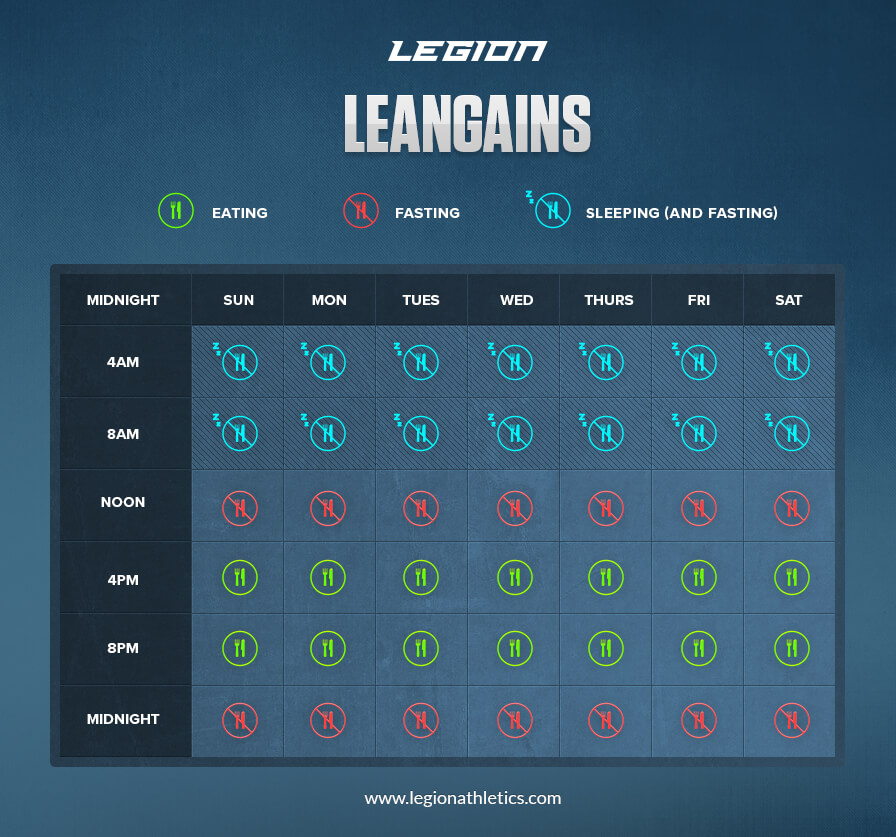
Leangains was created by Martin Berkhan and is the program that popularized IF in the bodybuilding space because it was built specifically for people looking to improve their body composition.
Here’s how it works:
You fast for 16/14 hours (men/women) and eat in 8/10-hour (men/women) “feeding windows.”
Your fasts begin after you’ve eaten your last meals and end with your first. For example, if you eat your last meal at 9 PM, then you don’t eat again until 1 PM the next day.
Sleep is going to be a large portion of your daily fast, of course.
While fasting, you’re not supposed to eat any calories, but black coffee, zero-calorie sweeteners, diet soda, and sugar-free gum are permitted.
It’s also recommended that you maintain a consistent fasting and feeding schedule because it will help minimize hunger while you fast.
You follow a high-protein diet.
This is vital for building and preserving muscle.
You eat more calories and carbs on training days than rest days.
This is known as calorie cycling and is useful for gaining muscle and strength while minimizing body fat storage.
That said, I feel it’s best suited to advanced weightlifters that are more or less happy with their overall development, not people who are far from their goals and looking to maximize muscle growth.
For the latter, I recommend a more traditional “lean bulk” approach to managing food intake.
Fasted training is optional.
There’s evidence fasted training results in a larger anabolic response to a post-workout meal than fed training, but this isn’t proof that fasted training will actually yield more muscle growth over the long term.
The downside to fasted training while trying to build muscle as quickly as possible is pre-workout carbs are quite ergogenic.
Eating 50 to 60 grams of carbohydrate ~30 minutes before your training can make dramatically improve your performance. And, over the long run, the better you can perform in your workouts, the better your progress.
Personally I only recommended fasted training for fat loss and highly recommend you combine supplementation with it to make it maximally effective.
You should eat a large post-workout meal.
Regardless of whether you train fasted or fed, Berkhan recommends a very large post-workout meal (it should be the largest meal of the day).
Shoot for 30 to 50% of your daily calories in your post-workout meal with a large amount of protein (50 to 100 grams).
The rest.
The program has a few more moving parts than what I’ve outlined above, so I recommend you just read Martin’s instructions in full to get the whole scoop.
Leangains Meal Plans
If Leangains sounds right for you, the next step is building some meal plans to follow.
These examples, which my team built as a part of our custom meal plan service, should help:
The Bottom Line on Leangains
The Leangains method was built specifically for weightlifters and people that care about their body composition, and is my personal favorite method of intermittent fasting.
The Warrior Diet
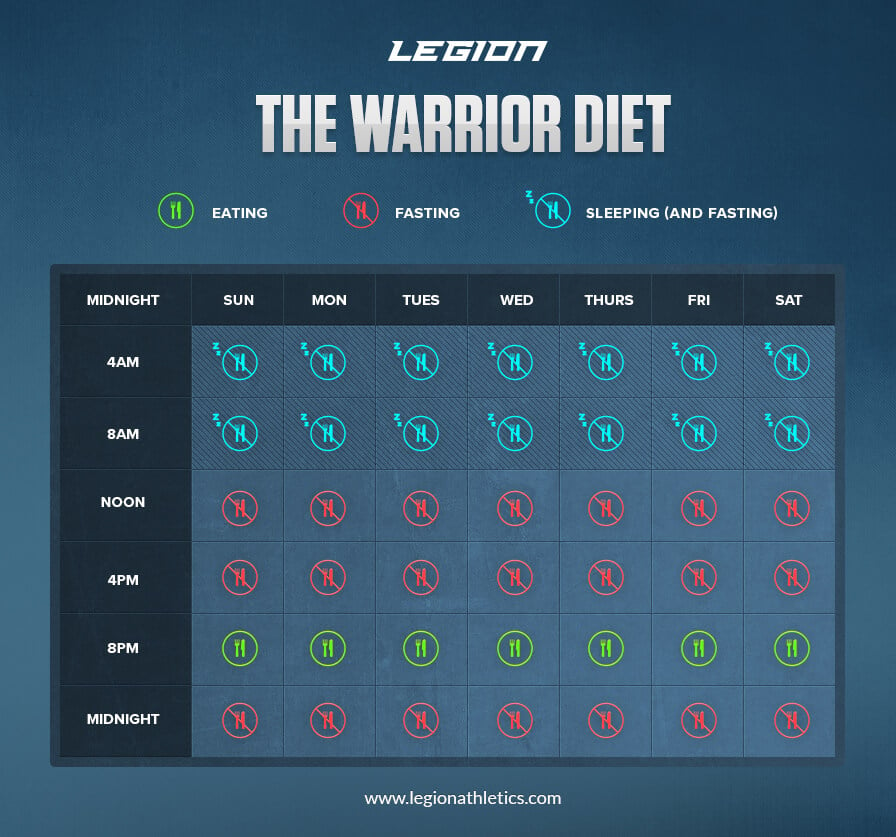
This is Ori Hofmekler’s method, as popularized by his book, and it entails fasting for 20 hours every day and eating the majority of your food in one large meal every night.
Furthermore, Hofmekler says you should start that big meal by eating vegetables, and then move to protein, and then fat. If, after eating in that sequence, you’re still hungry, only then should you eat carbohydrates.
Hofmekler’s theory is that humans are programmed for night eating and we can optimize our health and body composition by following our genetics. If we do this, he says, we can burn more fat, build more muscle, recover from our workouts better, enjoy better sleep, and more.
As you can guess, I think he’s grossly over-selling the benefits of the diet without sufficient scientific evidence to back up the major claims.
It’s also odd that the 20-hour “fasting” period isn’t really fasting because you’re allowed to eat a few small snacks of protein, fruit, and/or veggies (which elevate insulin levels and break the fast).
Warrior Diet Meal Plans
I’m not a fan of the Warrior Diet, but if you want to give it a go, here are a few examples of how you might lay out meal plans for the Warrior Diet.
The Bottom Line on the Warrior Diet
I don’t recommend the Warrior Diet unless you really like eating one large meal every day.
And even if you do, I wouldn’t recommend it if you’re weightlifting regularly. Your workouts are going to suck. You may or may not get enough protein. You probably won’t get enough carbohydrates.
Follow Leangains instead.
Eat Stop Eat
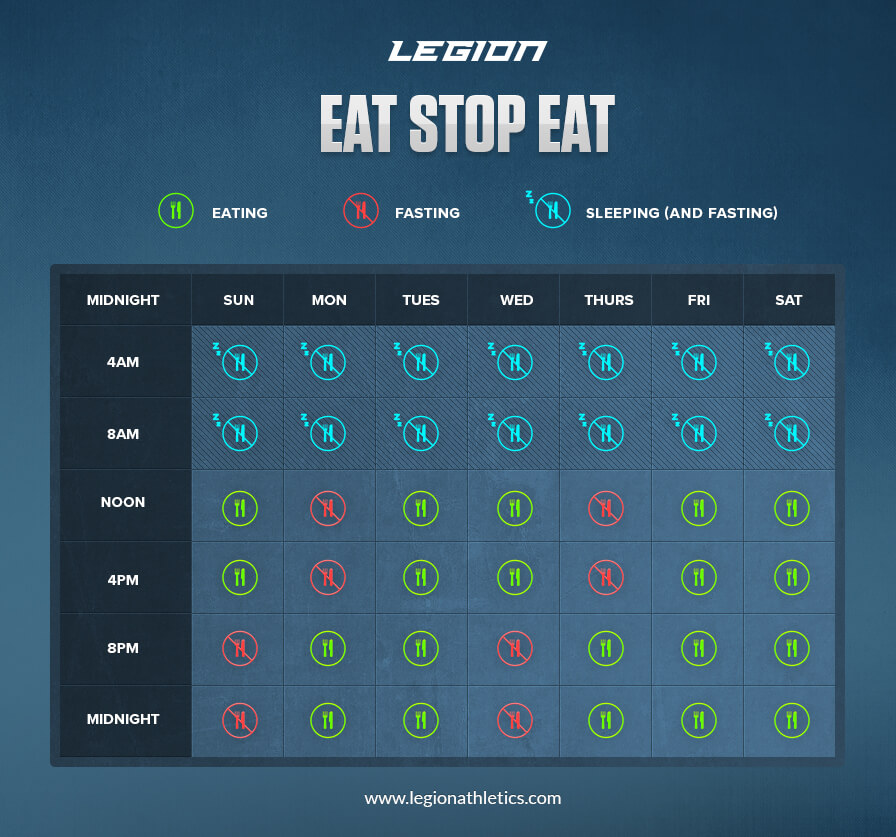
This method of intermittent fasting was created by Brad Pilon, and it’s very simple:
- Fast for 24 hours once or twice per week.
- You can start your fasts when you like, but they must go for 24 hours. They must be proper fasts, too–no food is allowed but, like Leangains, calorie-free beverages are okay.
If you can’t make it 24 hours, start by fasting for as long as you can and gradually increase this, working toward the full 24 hours.
To make the fasting easier, Brad suggests that you start your fast while you’re busy and on a day where you have no social obligations that involve eating.
Furthermore, it’s important that you break your fast with a normal meal. You shouldn’t pig out to “make up for” the calories you didn’t eat during the fast.
Brad also recommends that you exercise regularly, and places special emphasis on weightlifting for improving body composition.
The Bottom Line on Eat Stop Eat
The rationale behind the Eat Stop Eat is simple and sensible.
It simply allows you reap some of the health benefits of fasting while reducing your weekly calorie intake, which can result in “easy” weight loss…
…if you can endure the long fasting periods…
…and if they don’t lead to post-fast binges.
If you’re serious about weightlifting and gaining muscle and strength, though, or if you’re lean and looking to get really lean, I recommend Leangains instead.
Alternate-Day Fasting
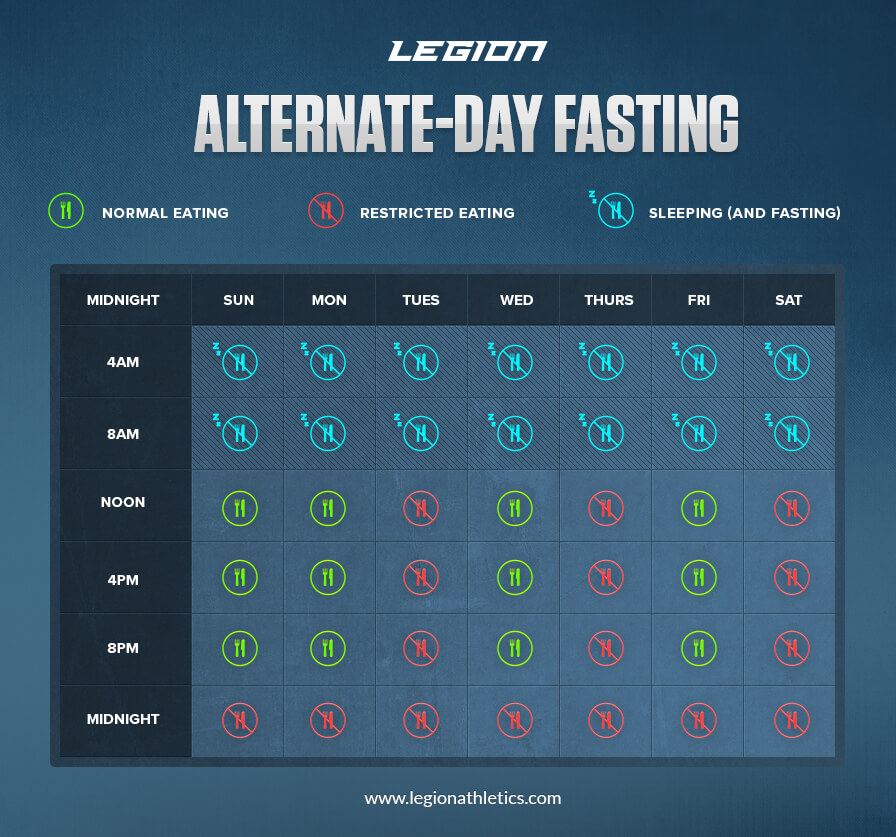
Alternate-Day Fasting (ADF) is a simple method of intermittent fasting that involves alternating between days of normal and restricted eating.
On “normal” days, you eat more or less the amount of energy you burn. On “restricted” days, you eat 20 to 25% of your energy needs (around 500 for most people).
Like Eat Stop Eat, the idea is simply to reduce your weekly caloric intake and thus help with weight loss. And it can work just fine.
The Bottom Line on Alternate Day Fasting
I don’t feel ADF is best suited to people that take their weightlifting and training seriously for two reasons:
- You can’t eat enough protein on your low-calorie days.
- Your workouts are going to be horrible on those days as well.
If, however, you’re not too worried about your body composition and you want to give intermittent fasting a go, ADF is a good place to start.
The Bottom Line on Intermittent Fasting

Like any popular brand of dieting, intermittent fasting is a victim of unreal hopes and expectations.
People are always hunting for the “magic bullet” for building muscle, losing fat, and getting healthy, and there will always be astute marketers ready to oblige them.
It would be great if manipulating your eating schedule alone could deliver all these things but it can’t.
Only an all-inclusive lifestyle of exercise, nutritious foods, good sleep hygiene, etc. can.
So…if you’re a healthy adult that exercises regularly, whether you should follow an intermittent fasting protocol or not really just boils down to how you like to eat, and what best fits your lifestyle.
Some people get really hungry after 10 to 12 hours without food and I don’t see any good reason for them to continue trying to jam the square peg into the round hole. They should just increase meal frequency until they find a nice sweet spot for their bodies.
I don’t run into hunger issues but don’t like the excessive fullness and lethargy that follows a large meal, and my schedule doesn’t lend itself well to shorter feeding windows, so intermittent fasting isn’t for me.
I know people that don’t mind eating large meals, however, and that find reducing meal frequency helps them stick to their diets. Intermittent fasting works well for them.
Even if you enjoy a more traditional style of dieting like I do, you can work in a bit of fasting here and there by just skipping breakfast. I’ll often do this on the days I don’t train because I just enjoy how it feels.
What’s your take on intermittent fasting? Have anything else to share? Let me know in the comments below!
Scientific References +
- Varady, K. A., Bhutani, S., Klempel, M. C., Kroeger, C. M., Trepanowski, J. F., Haus, J. M., Hoddy, K. K., & Calvo, Y. (2013). Alternate day fasting for weight loss in normal weight and overweight subjects: A randomized controlled trial. Nutrition Journal, 12(1). https://doi.org/10.1186/1475-2891-12-146
- Cermak, N. M., & Van Loon, L. J. C. (2013). The use of carbohydrates during exercise as an ergogenic aid. In Sports Medicine (Vol. 43, Issue 11, pp. 1139–1155). Sports Med. https://doi.org/10.1007/s40279-013-0079-0
- Deldicque, L., De Bock, K., Maris, M., Ramaekers, M., Nielens, H., Francaux, M., & Hespel, P. (2010). Increased p70s6k phosphorylation during intake of a protein-carbohydrate drink following resistance exercise in the fasted state. European Journal of Applied Physiology, 108(4), 791–800. https://doi.org/10.1007/s00421-009-1289-x
- Frecka, J. M., & Mattes, R. D. (2008). Possible entrainment of ghrelin to habitual meal patterns in humans. American Journal of Physiology - Gastrointestinal and Liver Physiology, 294(3). https://doi.org/10.1152/ajpgi.00448.2007
- Staten, M. A., Bier, D. M., & Matthews, D. E. (1984). Regulation of valine metabolism in man: A stable isotope study. American Journal of Clinical Nutrition, 40(6), 1224–1234. https://doi.org/10.1093/ajcn/40.6.1224
- Doi, M., Yamaoka, I., Nakayama, M., Sugahara, K., & Yoshizawa, F. (2007). Hypoglycemic effect of isoleucine involves increased muscle glucose uptake and whole body glucose oxidation and decreased hepatic gluconeogenesis. American Journal of Physiology - Endocrinology and Metabolism, 292(6). https://doi.org/10.1152/ajpendo.00609.2006
- Wilkinson, D. J., Hossain, T., Hill, D. S., Phillips, B. E., Crossland, H., Williams, J., Loughna, P., Churchward-Venne, T. A., Breen, L., Phillips, S. M., Etheridge, T., Rathmacher, J. A., Smith, K., Szewczyk, N. J., & Atherton, P. J. (2013). Effects of leucine and its metabolite β-hydroxy-β-methylbutyrate on human skeletal muscle protein metabolism. Journal of Physiology, 591(11), 2911–2923. https://doi.org/10.1113/jphysiol.2013.253203
- Wilson, J. M., Lowery, R. P., Joy, J. M., Walters, J. A., Baier, S. M., Fuller, J. C., Stout, J. R., Norton, L. E., Sikorski, E. M., Wilson, S. M. C., Duncan, N. M., Zanchi, N. E., & Rathmacher, J. (2013). β-Hydroxy-β-methylbutyrate free acid reduces markers of exercise-induced muscle damage and improves recovery in resistance-trained men. British Journal of Nutrition, 110(3), 538–544. https://doi.org/10.1017/S0007114512005387
- Rowlands, D. S., & Thomson, J. S. (2009). Effects of β-Hydroxy-β-methylbutyrate supplementation during resistance training on strength,body composition, and muscle damage in trained and untrained young men: A meta-analysis. Journal of Strength and Conditioning Research, 23(3), 836–846. https://doi.org/10.1519/JSC.0b013e3181a00c80
- Kimball, S. R., & Jefferson, L. S. (2006). Signaling pathways and molecular mechanisms through which branched-chain amino acids mediate translational control of protein synthesis. Journal of Nutrition, 136(1). https://doi.org/10.1093/jn/136.1.227s
- Pitkänen, H. T., Nykänen, T., Knuutinen, J., Lahti, K., Keinänen, O., Alen, M., Komi, P. V., & Mero, A. A. (2003). Free amino acid pool and muscle protein balance after resistance exercise. Medicine and Science in Sports and Exercise, 35(5), 784–792. https://doi.org/10.1249/01.MSS.0000064934.51751.F9
- Gjedsted, J., Gormsen, L. C., Nielsen, S., Schmitz, O., Djurhuus, C. B., Keiding, S., Ørskov, H., Tønnesen, E., & Møller, N. (2007). Effects of a 3-day fast on regional lipid and glucose metabolism in human skeletal muscle and adipose tissue. Acta Physiologica, 191(3), 205–216. https://doi.org/10.1111/j.1748-1716.2007.01740.x
- Horowitz, J. F., Mora-Rodriguez, R., Byerley, L. O., & Coyle, E. F. (1997). Lipolytic suppression following carbohydrate ingestion limits fat oxidation during exercise. American Journal of Physiology - Endocrinology and Metabolism, 273(4 36-4). https://doi.org/10.1152/ajpendo.1997.273.4.e768
- Febbraio, M. A., Chiu, A., Angus, D. J., Arkinstall, M. J., & Hawley, J. A. (2000). Effects of carbohydrate ingestion before and during exercise on glucose kinetics and performance. Journal of Applied Physiology, 89(6), 2220–2226. https://doi.org/10.1152/jappl.2000.89.6.2220
- Trabelsi, K., Stannard, S. R., Ghlissi, Z., Maughan, R. J., Kallel, C., Jamoussi, K., Zeghal, K. M., & Hakim, A. (2013). Effect of fed- versus fasted state resistance training during Ramadan on body composition and selected metabolic parameters in bodybuilders. Journal of the International Society of Sports Nutrition, 10(1). https://doi.org/10.1186/1550-2783-10-23
- Varady, K. A. (2011). Intermittent versus daily calorie restriction: which diet regimen is more effective for weight loss? Obesity Reviews, 12(7), e593–e601. https://doi.org/10.1111/j.1467-789X.2011.00873.x
- Harvie, M. N., Pegington, M., Mattson, M. P., Frystyk, J., Dillon, B., Evans, G., Cuzick, J., Jebb, S. A., Martin, B., Cutler, R. G., Son, T. G., Maudsley, S., Carlson, O. D., Egan, J. M., Flyvbjerg, A., & Howell, A. (2011). The effects of intermittent or continuous energy restriction on weight loss and metabolic disease risk markers: A randomized trial in young overweight women. International Journal of Obesity, 35(5), 714–727. https://doi.org/10.1038/ijo.2010.171
- Ohkawara, K., Cornier, M. A., Kohrt, W. M., & Melanson, E. L. (2013). Effects of increased meal frequency on fat oxidation and perceived hunger. Obesity, 21(2), 336–343. https://doi.org/10.1002/oby.20032
- Webber, J., & Macdonald, I. A. (1994). The cardiovascular, metabolic and hormonal changes accompanying acute starvation in men and women. British Journal of Nutrition, 71(3), 437–447. https://doi.org/10.1079/bjn19940150
- Zauner, C., Schneeweiss, B., Kranz, A., Madl, C., Ratheiser, K., Kramer, L., Roth, E., Schneider, B., & Lenz, K. (2000). Resting energy expenditure in short-term starvation is increased as a result of an increase in serum norepinephrine. American Journal of Clinical Nutrition, 71(6), 1511–1515. https://doi.org/10.1093/ajcn/71.6.1511
- Steekumaran Nair, K., Woolf, P. D., Welle, S. L., & Matthews, D. E. (1987). Leucine, glucose, and energy metabolism after 3 days of fasting in healthy human subjects. American Journal of Clinical Nutrition, 46(4), 557–562. https://doi.org/10.1093/ajcn/46.4.557
- Sherwood, L. M., Parris, E. E., & Cahill, G. F. (1970). Starvation in Man. New England Journal of Medicine, 282(12), 668–675. https://doi.org/10.1056/nejm197003192821209
- Durrant, M. L., Garrow, J. S., Royston, P., Stalley, S. F., Sunkin, S., & Warwick, P. M. (1980). Factors influencing the composition of the weight lost by obese patients on a reducing diet. British Journal of Nutrition, 44(3), 275–285. https://doi.org/10.1079/bjn19800042
- Carroll, S., & Dudfield, M. (2004). What is the relationship between exercise and metabolic abnormalities? A review of the metabolic syndrome. In Sports Medicine (Vol. 34, Issue 6, pp. 371–418). Sports Med. https://doi.org/10.2165/00007256-200434060-00004
- Faintuch, J., Soriano, F. G., Ladeira, J. P., Janiszewski, M., Velasco, I. T., & Gama-Rodrigues, J. J. (2000). Changes in body fluid and energy compartments during prolonged hunger strike. Revista Do Hospital Das Clínicas, 55(2), 47–54. https://doi.org/10.1590/S0041-87812000000200003
- Stote, K. S., Baer, D. J., Spears, K., Paul, D. R., Harris, G. K., Rumpler, W. V., Strycula, P., Najjar, S. S., Ferrucci, L., Ingram, D. K., Longo, D. L., & Mattson, M. P. (2007). A controlled trial of reduced meal frequency without caloric restriction in healthy, normal-weight, middle-aged adults. American Journal of Clinical Nutrition, 85(4), 981–988. https://doi.org/10.1093/ajcn/85.4.981
- Wegman, M. P., Guo, M. H., Bennion, D. M., Shankar, M. N., Chrzanowski, S. M., Goldberg, L. A., Xu, J., Williams, T. A., Lu, X., Hsu, S. I., Anton, S. D., Leeuwenburgh, C., & Brantly, M. L. (2015). Practicality of Intermittent Fasting in Humans and its Effect on Oxidative Stress and Genes Related to Aging and Metabolism. Rejuvenation Research, 18(2), 162–172. https://doi.org/10.1089/rej.2014.1624
- Varady, K. A., & Hellerstein, M. K. (2007). Alternate-day fasting and chronic disease prevention: A review of human and animal trials. In American Journal of Clinical Nutrition (Vol. 86, Issue 1, pp. 7–13). American Society for Nutrition. https://doi.org/10.1093/ajcn/86.1.7
- Hartman, M. L., Veldhuis, J. D., Johnson, M. L., Lee, M. M., Alberti, K. G. M. M., Samojlik, E., & Thorner, M. O. (1992). Augmented growth hormone (GH) secretory burst frequency and amplitude mediate enhanced GH secretion during a two-day fast in normal men. Journal of Clinical Endocrinology and Metabolism, 74(4), 757–765. https://doi.org/10.1210/jcem.74.4.1548337
- Harvie, M. N., Pegington, M., Mattson, M. P., Frystyk, J., Dillon, B., Evans, G., Cuzick, J., Jebb, S. A., Martin, B., Cutler, R. G., Son, T. G., Maudsley, S., Carlson, O. D., Egan, J. M., Flyvbjerg, A., & Howell, A. (2011). The effects of intermittent or continuous energy restriction on weight loss and metabolic disease risk markers: A randomized trial in young overweight women. International Journal of Obesity, 35(5), 714–727. https://doi.org/10.1038/ijo.2010.171
- Aksungar, F. B., Topkaya, A. E., & Akyildiz, M. (2007). Interleukin-6, C-reactive protein and biochemical parameters during prolonged intermittent fasting. Annals of Nutrition and Metabolism, 51(1), 88–95. https://doi.org/10.1159/000100954
- Bergamini, E., Cavallini, G., Donati, A., & Gori, Z. (2007). The role of autophagy in aging: Its essential part in the anti-aging mechanism of caloric restriction. Annals of the New York Academy of Sciences, 1114, 69–78. https://doi.org/10.1196/annals.1396.020
- Masiero, E., Agatea, L., Mammucari, C., Blaauw, B., Loro, E., Komatsu, M., Metzger, D., Reggiani, C., Schiaffino, S., & Sandri, M. (2009). Autophagy Is Required to Maintain Muscle Mass. Cell Metabolism, 10(6), 507–515. https://doi.org/10.1016/j.cmet.2009.10.008
- Kim, I., & Lemasters, J. J. (2011). Mitochondrial degradation by autophagy (mitophagy) in GFP-LC3 transgenic hepatocytes during nutrient deprivation. American Journal of Physiology - Cell Physiology, 300(2). https://doi.org/10.1152/ajpcell.00056.2010
- Surina, D. M., Langhans, W., Pauli, R., & Wenk, C. (1993). Meal composition affects postprandial fatty acid oxidation. American Journal of Physiology - Regulatory Integrative and Comparative Physiology, 264(6 33-6). https://doi.org/10.1152/ajpregu.1993.264.6.r1065

